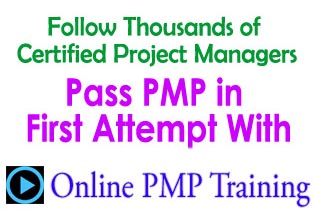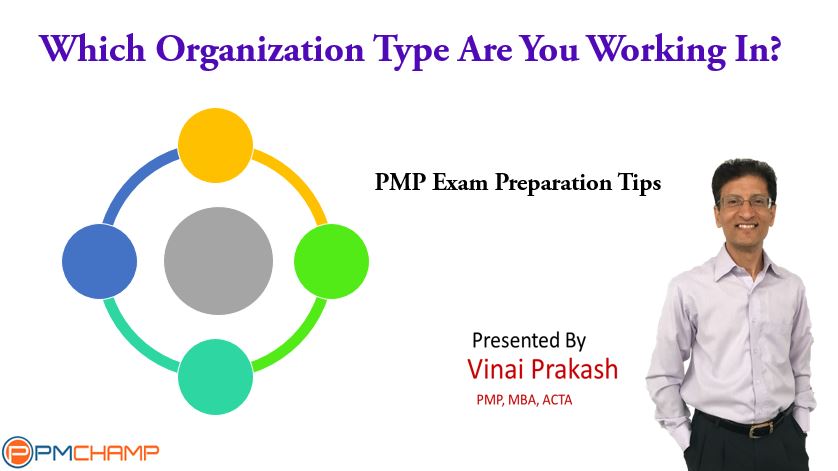For PMP questions, do you know which type of organization are you working in?
Many PMP exam questions won’t provide this information in the question. Yet, they expect you to know, and answer the question accordingly.
This can create problem and many people make the fatal mistake of answering the question from their own experience and perspective. They think about the kind of organization they work in, and apply it while answering the PMP questions.
As per the PMBOK Guide, Sixth Edition, there are 3 Major types of organizations – Functional, Projectized, and Matrix. Further, Matrix type of organization comes in 3 flavors – Strong Matrix, Weak Matrix and Balanced Matrix.
Some PMP exam questions will refer to these organization types, and some will not. Where it is referred, it may be quite useful to know this, and you can draw many insights from the pros and cons of each approach.
However, in this article, I want to highlight those questions, where the Organization Type is NOT mentioned in the Question.
What do you do then? How are you supposed to behave? What powers do you have, or you do not have, as a Project Manager?
This will have a direct impact on the way you answer the PMP question. But first, let us understand the basics…
Types of Organizations & Their Significance:
In general, the Functional Organization has departments, headed by department managers, like Sales Manager, Marketing Manager, Finance Director etc.Each manager has his own team of experts, or staff, who only work for that function. So the sales team does sales, and reports to the Sales Manager. Pretty simple. Resources are only available to project work, after permission is received from the Functional Manager.
In this kind of Functional organization, the project manager does not have much power, and actually reports to one of the functional managers. In terms of role, the Project manager is often referred to as a Project Coordinator (very little power), or a Project Expeditor (hardly any power) to plan and execute the project.
In sharp contrast, the Projectized Organization is headed by a Project Manager, who has absolute powers to do anything and everything on the project – hire, fire, plan, execute, do anything to get the project completed successfully. Full control.
The third kind, is a hybrid, mixed approach. The Matrix Organization falls in between the Functional and Projectized organization.
In the Weak Matrix, which is closer to the Functional organization, the Project manager has some more powers, but is still reporting to the functional manager. Kind of a Project coordinator.
In the Balanced Matrix, although the project manager is still reporting to the functional manager, his role is more independent, and has a much greater authority, which comes with the designation of Project Manager. Power is shared between the two managers, and the role is getting more clear cut. But resources for the project still belong to the functional manager.
The Strong Matrix type of organization is much closer to the Projectized org type. The Project Manager reports to the Manager of Project Managers, and acts at an equal footing with the Functional Manager. However, the resources still come from the Functional Manager, so you need to constantly battle for the same resources. The key difference is that in a Strong Matrix, the Project Manager has more control over the budget, resources, and how the money is spent on the project activities.
We have a detailed video highlighting the key features of each organization type, with many questions and answers to help you practice, in the PMChamp Online PMP coaching program. (this link requires membership to the PMChamp Coaching Program)
Understanding Org Type for the PMP Exam:
For PMP questions, the Project Manager is expected to take charge – he or she is supposed to get things done. Period. The leadership style is more directing, coaching, delegating and guiding, depending on the project status, and project team’s awareness and experience on the project and the project environment.
The Project Manager is also responsible for the Budget, the Scope, and deliver the project as per the agreed Timeline, and take care of building, managing, and coaching the team, to deliver the project on time, budget and scope.
Thus, the role expected from the Project manager tends to be more towards the Balanced Matrix to Strong Matrix type of organization, where there is more power for the Project Manager.
If nothing is given in the PMP exam question, assume that the organization type is a Balanced or Strong Matrix. Do not assume it to be completely Projectized, unless clearly stated.
If you work on this model, you can get many questions correct, because you know what to expect for the role of the project manager.
Some Resources from the PMChamp Archives – for helping you prepare for the PMP Exam
- 10 Important Points for the PMP Exam
- Answering PMP Questions – Part 1
- Answering PMP Question – Part 2
- 11 Things to Remember for the PMP Exam
- Best Resources for the PMP Exam (Updated)
- PMP Exam Preparation Books
Enjoy!
Cheers,
Vinai Prakash, PMP, ITIL, GAP
Founder and Chief Editor at PMChamp.com


Does PM has to negotiate with FM for resources and budget in a strong matrix org?
Hi Vijay,
Yes, in any matrix, there is a greater need for communication and negotiation between the PM & the FM. The degree varies… For resources, the PM must negotiate with the FM. After all, resources belong to the FM. As for the budget, the PM has more control of the project budget, but may need to negotiate regarding training, shared costs etc. with the PM. Hope this helps you… cheers -Vinai